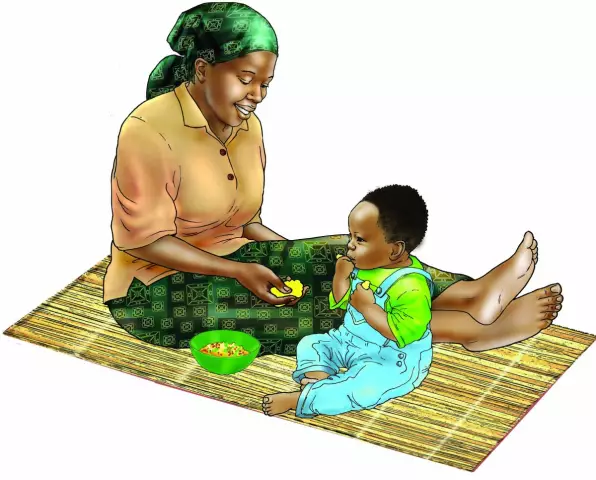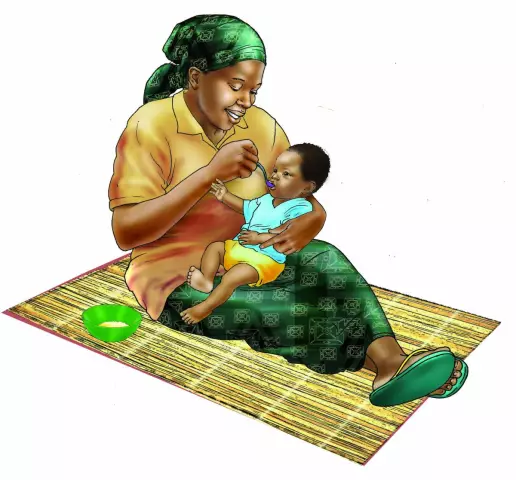- Author Rachel Wainwright [email protected].
- Public 2023-12-15 07:39.
- Last modified 2025-11-02 20:14.
Complementary feeding for children from 4 months
It seems that recently you just left the maternity hospital, and today your baby is already 4 months old. Every day and month of his life is marked by different events.

He is already quite firmly sitting in the highchair, curiously examining everything and everyone around. He developed an interest in adult food. It is interesting for a child to observe how and what adults eat. During this period, he begins to get acquainted with another nutritious substance. There comes a time when you can start talking about complementary foods from 4 months.
Do I need to introduce complementary foods for a 4 month old baby
The opinions of specialists in the field of baby food are unambiguously reduced to the fact that complementary feeding for children from 4 months should start based on the individual characteristics and health of the child. In addition, it also depends on the effectiveness of breastfeeding. That is, whether the mother's milk has all the necessary nutrients and is being produced enough.
Ideally, breast milk is still the main food for a baby at 4 months. But by this age, due to natural norms, the reflex of pushing solid food out of the mouth with the tongue is fading away. Consequently, the child prepares to eat more solid foods.
According to the recommendations of pediatricians, complementary foods should be introduced to a child at 4 months old because, earlier than this age, the baby is not yet prepared to accept other food, except for breast milk, according to its physiological capabilities. But even after 6 months it is too late to start introducing complementary foods. Since there may be inconveniences when the child adapts to denser food.
How to start feeding a 4 month old baby
In order to decide on complementary foods for a 4-month-old baby, you need to consider the physiological parameters of his health. For an overweight child, it is advisable to start complementary foods with vegetable purees. Vegetable purees are also suitable for children prone to constipation. In case of unstable stools or lack of weight, it is recommended to start complementary foods with cereals. If your child is completely healthy and does not have such problems, then nutritionists advise starting complementary foods with vegetable purees.
Complementary feeding is a substitute food for an infant. It is introduced into the nutrition of children to replace mother's milk, which can no longer provide a full filling of the baby's body with the necessary energy resources.
You cannot start feeding a baby if he is sick or received a preventive vaccination.
It is advisable to give the first complementary foods to children from 4 months before breastfeeding, since a hungry baby is likely to perceive the "innovation" positively. You need to start with one teaspoon. And exactly the spoons. Within 1-2 weeks, the volume of complementary foods is brought to about 100-150 grams, depending on the weight of the child.
Pay attention to the child's condition throughout the day so as not to miss possible allergic reactions and other troubles.
What products are complementary foods for a 4 month old baby
If your child is healthy, then, as we have already said, it is advisable to start complementary foods with vegetable purees. First of all, because vegetables have a significant amount of nutrients that are easily absorbed by the child's body.
Try starting complementary foods with cauliflower, pumpkin, squash, potatoes. These vegetables are the least dangerous in terms of allergic reactions. It should be noted that babies sometimes find it difficult to get used to food that does not look like mother's milk. There is no need to despair, over time the child will get used to vegetable purees. You should not immediately make a variety of complementary foods. The child's body must adapt to each vegetable gradually. You can alternate between vegetable purees and fruit purees, provided that the child is already familiar with fruit juices. But remember that the sweet taste of the fruit can kill your appetite for fairly bland vegetable purees. If you decide to introduce fruit purees, then give preference to apples.
You need to start feeding your baby with cereals with single-grain cereals - rice or buckwheat. Buckwheat is a neutral product and is rich in many vitamins, but rice porridge, for all its usefulness, can cause constipation. Later, millet and corn porridge can be introduced.
The introduction of cereals is due to the fact that they are easier to digest, and cereals are full of iron and zinc, which is no longer enough in breast milk.
Porridge for the first feeding of children from 4 months should not be dairy. You can dilute the water with breast milk or milk from the children's kitchen.
How to properly feed a baby at 4 months
Feed your baby non-violently only when he is hungry. Place him on the highchair facing you. So it will be more convenient for him. Spoon feed from a distance of about 20 centimeters from his face.

Wait for the baby to notice the food and open its mouth. Take your time, choose a feeding pace that is comfortable for the baby. Don't force him to eat more than he wants.
It so happens that he didn't like the food the first time. Do not impose, try again in a day or two.
When the baby gets used to it, he himself will begin to open his mouth, and sometimes even help himself with his pens.
If the baby is full, he turns his head and shrugs off the food.
Starting complementary feeding of a child from 4 months, remember that during this period the formation of the mechanism of swallowing and local intestinal immunity occurs. Your baby is still very small, be attentive to his body. Observe their health and behavior during complementary feeding. Raise a healthy and strong baby.
Found a mistake in the text? Select it and press Ctrl + Enter.






